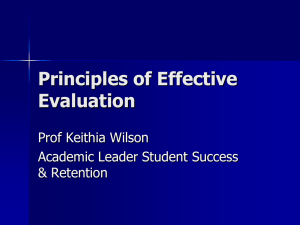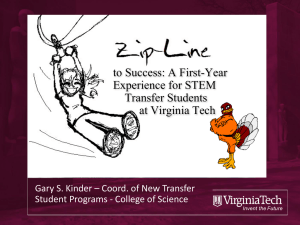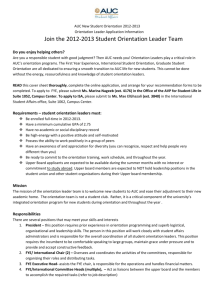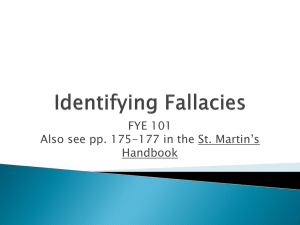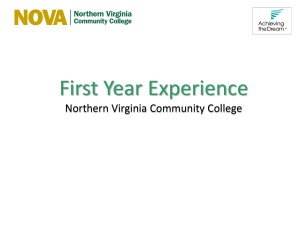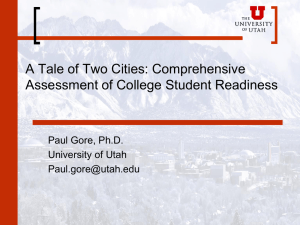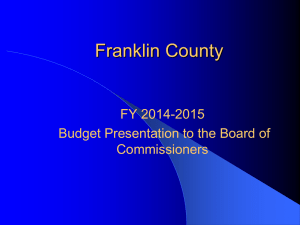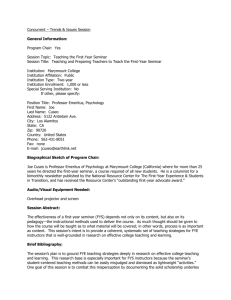2015 FYE Instructor Lesson Plan
advertisement
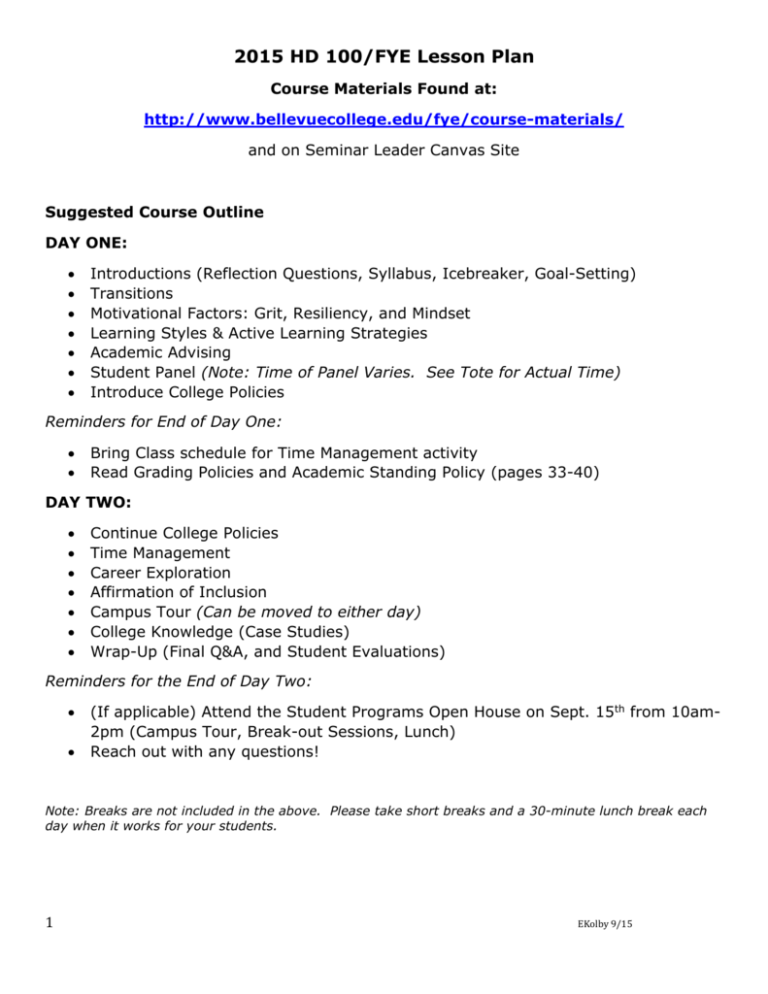
2015 HD 100/FYE Lesson Plan Course Materials Found at: http://www.bellevuecollege.edu/fye/course-materials/ and on Seminar Leader Canvas Site Suggested Course Outline DAY ONE: Introductions (Reflection Questions, Syllabus, Icebreaker, Goal-Setting) Transitions Motivational Factors: Grit, Resiliency, and Mindset Learning Styles & Active Learning Strategies Academic Advising Student Panel (Note: Time of Panel Varies. See Tote for Actual Time) Introduce College Policies Reminders for End of Day One: Bring Class schedule for Time Management activity Read Grading Policies and Academic Standing Policy (pages 33-40) DAY TWO: Continue College Policies Time Management Career Exploration Affirmation of Inclusion Campus Tour (Can be moved to either day) College Knowledge (Case Studies) Wrap-Up (Final Q&A, and Student Evaluations) Reminders for the End of Day Two: (If applicable) Attend the Student Programs Open House on Sept. 15th from 10am2pm (Campus Tour, Break-out Sessions, Lunch) Reach out with any questions! Note: Breaks are not included in the above. Please take short breaks and a 30-minute lunch break each day when it works for your students. 1 EKolby 9/15 Course Materials Found at: http://www.bellevuecollege.edu/fye/course-materials/ and on Seminar Leader Canvas Site Suggested Course Outline for Quarterly FYE: Week 1: Introductions (Syllabus, Icebreaker, Goal Setting) & Transitions Week 2: Campus Tour Assign Resiliency Assessment (page 16) for weekly reading Week 3: Motivational Factors: Grit, Resiliency, and Mindset Assign Reading for Meaning, Test Taking, and Note Taking (pages 10-15) for weekly reading Week 4: Learning Styles & Active Learning Strategies Assign Grading Policy and Academic Standards Policy (pages 33-40) for weekly reading Week 5: College Policies/Time Management (if time) Assign Time Management activity to complete during the week Week 6: Review Time Management activity/Academic Advising Week 7: Career Exploration Week 8: Catch-up Time (Finish Academic Advising, Career Exploration) Week 9: Affirmation of Inclusion Week 10: College Knowledge (Case Studies) Notes: 2 Complete course evaluations during last course meeting. If 11 weeks available, use time to review any lessons that may have gotten cut short or take time to do campus Q&A EKolby 9/15 Introduction to Class Description: Welcome, Reflection Questions, Syllabus, Icebreaker, Goal Setting Time: One Hour Pages in Manual: 3, 4 Slides in PPT: 1-4 Additional Materials: Nametags, Syllabus (handout in tote) Outcomes: As a result of this part of FYE, Students will… View FYE as a welcoming and engaging environment Understand how to be successful in FYE Get to know you and their classmates Describe the process of goal-setting and understand the difference between a short and long-term goal Welcome Students o Arrive at least 15-20 minutes prior to the scheduled start of the seminar o Put up first slide on PPT, and write the following instructions on the board: “Please take a manual, fill out a nametag, and complete the questions in the “Before FYE” section on page 3” o As students arrive, ask them their names and indicate on the roster if they are present. If student is not on roster, check master roster and direct student to appropriate section as needed. o Once you feel that it is time to begin, read the attendance roster again to make sure all names have been called. Review “What is FYE/Why FYE?” (Slide# 2) o FYE is one credit and is mandatory for new students. o “FYE is a place to learn how to be a successful student at Bellevue College” Success means different things to each of us. For our purposes in FYE, success = reaching your academic goal(s) Pass out FYE Syllabus Ask: Who has ever had a syllabus for a class before? How is it useful? Explain: “Here at Bellevue College (and in college in general), a syllabus is a contract between you and your instructor. It explains what you will learn as a result of the course, important policies, and it provides a timeline of important dates and deadlines for assignments. By remaining in the course, you are accepting your end of the contract.” Review syllabus either using popcorn reading or by highlighting each section yourself. 3 EKolby 9/15 Introductions Explain: “Bellevue College is a large school with over 18,000 full-time students. In FYE, one of the goals is that you will get to know other new students like yourself as well as get to meet one Bellevue College instructor before the quarter starts.” Review Instructor Introduction Slide (Slide# 3). Feel free to customize the slide any way you want and/or add pictures! Icebreaker. Note: You may want to divide the group into two or more groups for the icebreaker depending on class size. o Option #1: Name Game with Hand Motions Students stand in a circle. When it is their turn, they say their name and something they like to do with a hand motion (“My name is Emily and I like playing football”—motion of throwing a football). The next person must repeat the previous name and hand motion, etc. The last person then repeats all names and hand motions. You can apply this icebreaker to the Learning Styles part of class. This can also be played with two groups racing to finish first. o Option #2: Toilet Paper Introductions This will require you to bring a roll of toilet paper. Instruct students to pass around the roll of toilet paper, breaking off as many squares as they would like (but not told why). Once everyone has torn off squares, they must share with the group one thing about themselves per square. Works well in groups of 10 or less, so dividing class might work best. o Option #3: Class Whip-Around The purpose of a whip-around is to move quickly from person to person. Each student shares their name and completes the sentence, “The Number One thing I’m looking forward to at Bellevue College (or FYE) is _______.” (or another whip-around topic of your choice. Goal Setting Review: Goal setting information on Slide# 4 and Page #4 4 Ask students to brainstorm some other examples of strong and not-sostrong goals related to specificity, attainability, and things they may want. Give students 5 minutes to brainstorm goals for FYE and their Bellevue College experience. Emphasize that goals will help them decide what they want out of each experience. EKolby 9/15 Transitions Description: Introduces Schlossberg’s Transition Theory and the “4 Ss,” as well as a time to discuss the difference between high school, college, and the working world Time: 45 minutes Pages in Manual: 5, 6 Slides in PPT: 5-6 Additional Materials: None Outcomes: As a result of this part of FYE, Students will… Understand the definition of Transition and describe terms situation, self, support, and strategies Begin to understand the application of the 4 Ss to their current transition into college, as well as view other transitions in their life through the lens of Schlossberg’s work Distinguish the difference between their roles as a high school student, college student, and employee Define “Transition” Ask students what they think a transition is before having them open to page 5 Read Aloud the two different definitions on page 5. Discussion Questions: What is the difference between these two definitions (aside from length)? What do you think Schlossberg means when she uses the word “nonevents?” “Questions to Ponder” (page 5) Students can write down their responses on page 5 Transitions Theory Explanation Explain “Why Theory?”: “We use theory as a way to make sense of the world around us, as well as certain situations we encounter in our day-to-day lives. You will come across many theories in many different subjects (science, philosophy, psychology, etc.) as you move through college. We are using Scholossberg’s Transition Theory in our FYE class to help us better understand how to make sense of the transition into college. Schlossberg's Transition Theory is an adult development theory focused on the transitions, or events, that adults experience throughout life and how they cope and adjust to these changes. When a transition occurs, a process takes place as an individual integrates changes into his or her daily life. There are four aspects of a transition that affect how well we deal with change.” Ask students to read aloud the “S”s. Check-in with them for possible examples, as related to college or other transitions. 5 EKolby 9/15 Refer back to Reflection Questions on page 3 for Think/Pair/Share Give students more time to complete if they haven’t already Emphasize that these questions actually align with the “4 S”s , and we want students to begin thinking about how they will make the transition into college. Students pair up and share out with each other (and then the class) support and strategies responses. Explain that some of the responses may be personal, so support and strategies may be the most applicable in an effort to learn from each other. Transitioning to College Table (Slide 6, Page 6) 6 After students have finished sharing out with each other, they can turn to page 6 and review the Transitioning to College Table Emphasize that these are generalized differences. As an instructor, feel free to add or differentiate between what you do and what is written on the table Ask: o What is surprising to you about what is on the table? o Are there already strategies that you can think of for being a successful college student versus what you had to do in high school or what you do at work? EKolby 9/15 Motivational Factors Description: Provide introduction to what resiliency, grit, and mindset mean in the context of college. Students reflect on what it means to “bounce back” after challenges—the resources they have and the power within themselves. Time: 45 minutes Pages in Manual: 16-17 Slides in PPT: 7-8 Additional Materials: Mindset handout (optional—no copies provided for students; copy in tote) Outcomes: As a result of this part of FYE, Students will… Be able to explain what resiliency, grit, and mindset mean Begin to identify characteristics of those who are resilient and able to bounce back Introductory Explanation: “The first 6 weeks of the first quarter of college can be full of extreme highs and lows for a first-year student. The transitions from summer vacation to FYE to midterms can be both physically and emotionally exhausting. This is also a time when many students encounter significant setbacks: poor performance on a midterm, difficulty making friends, challenges with sleep patterns, dissatisfaction with an intended major and frustrations navigating a new system, among others. This piece of our time together is focused on exploring the power of resiliency in overcoming setbacks that you may face. We are going to watch some video clips and reflect on our own ability to bounce back.” Video Clip: “Famous Failures”: https://www.youtube.com/watch?v=zLYECIjmnQs Discussion Question: Did any of you know this information beforehand? How does it make you feel hearing it again or for the first time? What do all of these individuals have in common? Review Resiliency Definition (Read aloud): The power or ability to return to the original form, position, etc., after being bent, compressed, or stretched; elasticity. Ability to recover readily from illness, depression, adversity, or the like; buoyancy. Resiliency Assessment (pages 16-17) Read introduction on page 16. Students take 10-15 minutes to fill it out quietly Questions to Pose to Group (For them to ponder—not necessarily to answer aloud) How did you feel when filling out the assessment? 7 EKolby 9/15 Were there certain areas on the wheel that stood out as having more or less “yes” and “no” answers than the others? Video Clip: The Power of Belief: https://www.youtube.com/watch?v=pN34FNbOKXc (Video Transcript found here) Discussion Questions: What one thing from the video would you want to share with others? What do you think is the “take-away” message of this video? What is the difference in thought patterns between someone with “Fixed Mindset” and “Growth Mindset?” How might the concepts of resiliency and mindset be related? How might these concepts assist you in life transitions (beyond your first quarter in college)? Additional Videos/Articles: • The Key to Success? Grit (TedTalk Video– captions and interactive transcript avail) • Fixed v Growth Mindset Handout (If using, will need to make copies—not provided in tote; phrases included on PPT. Student reframe fixed mindset phrases into growth mindset phrases.) True grit (Seattle Times Article About the Seahawks) 8 EKolby 9/15 Learning Styles & Active Learning Strategies Description: Learning Styles Inventory and activity. Study strategies with activity Time: One Hour and 15 minutes Pages in Manual: 7, 8-15 Slides in PPT: 9, optional Jeopardy PPT Additional Materials: Markers, easel paper Outcomes: As a result of this part of FYE, Students will… Identify their own preferred learning style and begin to develop study and in-class strategies related to it Identify practical strategies for test taking, note taking, and reading for meaning Learning Styles: Students complete the Learning Styles Inventory in Manual on page 7 Students raise hands to look and see how many styles are represented in the room. Discussion Questions: o Were you surprised by your style? o Which style had the most representation? Is this surprising? What does this mean? Activity Option 1: Learning Styles Representation o Split the class into equal groups (three to four) representing their top or second preference of learning style. o Each group will have 10-15 minutes to create a presentation (skit, demonstration, drawing, or explanation) to tell the rest of the class about their learning style and to show how they learn best. o Ask the rest of the class to guess which style is represented and each group to explain why they made the choices they did in their presentation. Option 2: Making Paper Airplanes 9 Split the class into four groups and explain that each group will create a paper airplane as described below: o Written Instructions (enough copies for everyone to read along): Each group member is able to read and follow the written instructions. o Read-Aloud Instructions: One copy for this group. Group members create paper airplane based on what is read to them. Not allowed to ask questions of the reader. EKolby 9/15 Diagram Instructions (aka “IKEA instructions): Group members create a paper airplane based on the step-by-step diagram instructions they are given. o Demonstrator: Ask who in the group has made a successful paper airplane before (or assign at random!), and that person will demonstrate to the group/instruct as they all make their airplanes. After 5-7 minutes, test the airplanes! Make note of to which team the most successful plane belonged. Discussion Questions: o How did it go? What worked? What was challenging? o How might each of the groups represent a learning style on the original inventory? How were these groups different? o How might this represent learning environments? What happens when an instructor is teaching in a style that may not mesh well with your own? o Option 3: Read and review the Blog Post “The Science of Smart” http://www.pbs.org/wgbh/nova/blogs/secretlife/blogposts/the-science-ofsmart-forget-about-learning-styles-heres-something-better/ Discussion Questions: Do you believe that the concept of “Learning Styles” is accurate? Why or why not? Ask students to reflect on which kind of learner they are or aspire to be: a surface, strategic, or deep learner Active Learning/Study Strategies Jeopardy Game 10 Explain “Some of these may be strategies you have used before or learned about in high school; however, many college students find that they have to take a more active approach to discovering what study methods work best. There may also be additional strategies that aren’t mentioned today that you already know are successful. This is all about filling your toolbox with strategies you can rely on when needed.” Split the class into three or four equal groups (depending on class size). Each group will need to elect a captain. Perhaps they may already be in three groups after Learning Strategies, and this is fine. Ask for a volunteer to keep score and assist in determining who “buzzes in” first. Give each group 15 minutes to “master” the material in the manual: Test Taking (p. 10), Note Taking (p. 12), and Reading for Meaning (p. 14). It is up to them how they want to do this. It may work best to add a brief break in the middle of this module, so that students have even more time if they would like. Play the Jeopardy Game on the separate PPT (download from FYE Couse Materials site). Record score for each team. Teams will “buzz in” when the captain raises his or her hand. They will be given five seconds to confer with their team and answer the question. They are now allowed to “buzz in” while you are still reading the question. As the instructor, feel free to add on to any answers and give your perspective on the strategies—especially the Final Jeopardy Question! EKolby 9/15 Academic Advising Description: Discussion of Academic Advising resources (staff and tools) and academic goal setting Time: 50 Pages in Manual: 21-23, 27 Slides in PPT: 10-11 Additional Materials: White board marker, Post it notes (1 per person) Outcomes: As a result of this part of FYE, Students will… Students will be able to identify their academic advisor and will know why they would visit their advisor/what kinds of questions they can ask their advisor Students will be able to articulate which degree or program of study they are working on at BC as well as what their future major or area of interest is Students will set at least two goals for achieving their academic and/or career aspirations Students will be able to identify three advising resources Introduction: Have students turn to someone next to them and share what classes they are most excited about taking during Fall Quarter (or beyond). Advising Video: Play video for students – see link on PowerPoint (5 min): Explain to students that they should be taking notes about (1) Which advisors they could see for their program of study (2) Keys to success that they find helpful or new from the video. They should record these tips on pages 42-43 of their manual for use after the video After video, have students record at least one academic advisor that they could see for their area of study on the worksheet on page 27 of their manual (slide #16). Review how to make an academic advising appointment with students. Write the advising office phone number (425-564-2212) and office number (B232) on the board for students to record on page 27 of their manual. 11 Students can call the advising office or stop by the front desk to make an appointment. We will make an appointment with them based on the correct advisor for their area of study’s availability. We cannot guarantee a same day appointment although we try to get students in as soon as possible. Students will need their student ID number to make an appointment and it is helpful if they tell the front desk what they are studying. Remind students that they will need to make an advising appointment in late October or early November to discuss Winter Quarter Registration with an advisor – this is the student’s responsibility! There is no automatic appointment made for them. Have them record this on page 27 of their manual EKolby 9/15 Discussion Questions in Pairs (15 min): Have students record the answers to these prompts on page 27 of their manual. Then have students pair up and share with each other their answers to the prompts they have answered. 1. What is your current area of study? If transferring eventually what would you like to major in? 2. What degree or program of study are you working on here at Bellevue College? Why did you chose this degree or program of study? (Students can reference page 23 of their manual to see our most common majors matched with the correct degree choices) 3. What is your future career goal? Have students help each other in pairs or small groups to create at least two goals each that will help them work towards their future major or area of study or career goal. Students may create and record their goals on page 27 of their manual. (Remind students to reference page 4 of their manual regarding setting good short and long term goals). Have each student write down one of their goals that they are going to commit to for the coming year on a post it note. Have each student come up and post their goal on the board in the front of the room. Depending on your group you may want to have them read their goal aloud as they post them on the board or have students come up and read the goals to themselves Large Group Discussion (10 min) Use the following questions (also on PowerPoint): How can an academic advisor help you towards these goals? When should you see an advisor to talk about these goals? How often? (questions on page 22 of manual could help) How can you help each other towards these goals? What are some ways you can keep yourself motivated/accountable towards these goals? Introduce/Review Advising Resources (15 min) Direct students to page 21 in their booklet Remind students about online class schedule and online services. Show students these pages just to remind them what they look like and any key links. Sample SID/PIN for Degree Audit: SID: 954999999 PIN: 1234 Talk about Degree Audit and how to use this as a tracking tool with your educational plan i. How to log in ii. How to choose the correct degree from the drop down iii. How to tell what you’ve taken and how it fits into your degree and what you still need to take iv. How to find classes that fulfill your requirements Wrap-up & General Questions (5 min) Remind students about the advising webpage and where advising main office is located 12 EKolby 9/15 Student Panel Description: Students from Student Programs (or Athletes or TRiO students, depeding on section) visit the FYE section to give their perspective on life as a BC student. Note: May actually occur much earlier in the day—see tote for actual timing. Time: 30 Minutes Pages in Manual: 41-42 (notes pages) Slides in PPT: 12 Additional Materials: none Outcomes: As a result of this part of FYE, Students will… Begin to identify strategies used by current students when faced with challenges in college Receive answers to other questions about college life that are relevant to them Introductory Explanation: “As we talked about before, Bellevue College can sometimes seem like a large place. We are excited to introduce you to some current Bellevue College students who are looking forward to sharing with you their tips for success.” Welcome Student Panelists. Ask them to introduce themselves, their area of study, and talk about any clubs/organizations in which they are involved. Prompt Panelists by asking the guiding question on Slide# XX. Time Permitting, open up the discussion to other questions students in the class might have. Student panels may have copies of the Student Handbook to deliver and briefly introduce. Logistical Notes: Students panelists will ask you to sign a sheet proving they attended. Some panels may be running a few minutes behind, as they are scheduled back-to-back. If possible, try to wrap up previous module or figure out a way to come back to it after the panel and allow the panelists to being as soon as they arrive. If panelists don’t arrive at designated time, please continue on with the curriculum. Please let Emily know about any mishaps or question that you may have about this part of FYE. 13 EKolby 9/15 College Knowledge: Policies Description: Students will develop an understanding of the college Grading and Academic Standards Policy so that they have a strong basis for continued academic goal development during their first quarter. Time: 45 minutes Pages in Manual: 33-35, 36-40 Slides in PPT: 15 Additional Materials: n/a (perhaps a chime or other device to capture attention) Outcomes: As a result of this part of FYE, Students will… Make personal meaning of and connect their academic goals back to two specific BC policies. Have a chance to ask questions regarding BC grading and academic standards. Assign students the policies as reading prior to this module (see slide 11). In the two-day model, this would be a good way to start the second day. Mix-Pair-Share Activity with Questions Instructions: Students mill around the room silently. After 10-15 seconds, get their attention, and they pair up with the closest person. Those not next to someone are instructed to raise their hand and pair up. Students introduce themselves to their partner. Students are first presented with a question from the list below to ponder, then share with partner, then share with whole class voluntarily. Questions for students (also found on PPT): 1. Why do you think Bellevue College has these two policies? 2. What does it mean for you knowing that your grade point average has to stay above a 2.0 (C) in order to remain a student at Bellevue College? 3. Do either of these policies connect with the goals that you wrote at the beginning of class? If so, how? 4. What follow-up questions do you have after reading the Grading Policy? (Seminar Leader can record questions that are shared out with whole group) 5. What follow-up questions do you have after reading the Academic Standing Policy? (Questions can also be recorded) If you are unsure about answers to student questions related to these policies, it is a good opportunity to get back to the students following the class with the answers! 14 EKolby 9/15 Time Management Description: Students will explore their own personal time management using their class schedule and guiding strategies. Note: Works best on Day Two so that students have their class schedules Time: 45 minutes Pages in Manual: 18-20 Slides in PPT: 16-17 Additional Materials: Students will need their own class schedules Outcomes: As a result of this part of FYE, Students will… Identify strategies for personal time management Begin to build their personal weekly schedule and understand the complexities of balancing school and life Define Time Management Read Slide # 14. Emphasize that it is all about choices that we make. It is actually impossible to manage (slow down or speed up) time, but we can make decisions about how we spend our time more wisely. Play video on Slide# 14 (Ellen’s Procrastination). http://www.youtube.com/watch?v=s9SWJRwvHb4 Ask students, “can you relate?” If there was laughter, “why is it that we laugh?” Name Time Management Strategies Ask students about their own personal strategies What are you already doing in your own life? Do you keep a planner or a calendar? What could you do to improve your time management? Read through pages 18-29, highlighting specific strategies that you recommend. If students feel comfortable, they can popcorn read. Optional Video with more suggestions: “The Science of Productivity” https://www.youtube.com/watch?v=lHfjvYzr-3g Time Management Activity (15 minutes) Read the instructions on page 19. If students did not bring their own class schedule (or can’t remember it), write a sample schedule on the board (see next page). If students do not have a standard work schedule, recommend they use one from the current week or one that seems the most typical. Float as they complete this activity. Check that they are scheduling enough study time (2 hrs for every one hour in class. They will need to multiple the number of 15 EKolby 9/15 hours in class/credits to get the total study hours), meal times, and travel time. If students seem resistant or confused, explore this and ask them about that feeling—is the exercise overwhelming or something that they don’t think will work? Follow-up Discussion Review questions on page 19: What is surprising about your weekly schedule? Do you notice any patterns? What if you ran into an unexpected emergency or needed to change your schedule? Visit TRiO page www.bellevuecollege.edu/trio/services/study-skills/ to show students where to download more calendars. Wrap-up Activity: Do a whip-around* with the question “one way I waste time is…” or “One thing that I noticed about my weekly schedule is…” If students do not have their schedule/can’t remember their classes, use this sample schedule: Classes: English 092 (5 credits), Daily 8:30am-9:20am Sociology 101 (5 credits), Daily 10:30-11:20am Astronomy 101 (6 credits), Online Work Schedule: 16 Hours/week, Mon/Tues/Wed/Thurs 2pm-6pm *whip-around = time for QUICK responses. Students respond with one or two words tops!) 16 EKolby 9/15 Career Exploration Description: Discuss elements that go into finding a career that “fits”; provide resources for next steps (e.g., WOIS) Time: 45 minutes Pages in Manual: 24, 25-26, 27 Slides in PPT: 18-24 Additional Materials: none Outcomes: As a result of this part of FYE, Students will… Describe the process of exploring different majors and careers Define “values,” “interests,” “personality,” and “skills and strengths,” as they relate to identifying a career Take with them concrete resources (WOIS) and on-campus services to continue exploring on their own Introduce Concept: “Don’t worry, today we will not be choosing majors or careers. Rather we will be learning about the process to follow to make that choice.” Read paragraph at the top of page 24 Ask students to name: o A major that very clearly leads toward a career (e.g., Engineering, Broadcast Journalism) o A major that does not necessarily lead toward a career (e.g., English, History) What are some skills that you can draw on from those majors to be successful in a career (e.g., reading, writing, public speaking) Ask students to think about someone they know who is satisfied in their job/career. What do you think contributes to their satisfaction? Can you imagine this person participating in any other sort of career? Play Video Clip, “George Ponders a Career” https://www.youtube.com/watch?v=2LCggmsCXk4 Discussion Questions: 17 What is happening in this clip? Why might we find it funny? Thinking about the four aspects of choosing a career (values, interests, personality, and skills and strengths), what is George considering? What is he not considering? What steps would you recommend as he continues to ponder? EKolby 9/15 Option 1: Holland Code Activity Students complete the questionnaire on page 25 of their manual. Float as they complete, as some of the tasks may need clarifying/further explanation. Using the table of activities, students will identify their Holland Code in Step 2. Poll the class to see how many students had Realistic, Investigative, Artistic, Social, Enterprising, or Conventional as their top category. Refer students to page 26 to see just a few examples of careers in those areas. +WOIS explanation Explain that the activity is the first step in exploring a potential career. An online resource like WOIS can help in providing concrete information like educational obtainment, potential salary, and potential openings in WA State. Visit http://www.wois.org. It is free, and you will not need a site key when using it oncampus. To use off-campus, students need a site key, which they can obtain from the Career Center. Click on “Occupations” on the menu on the left. You can search by “Career Clusters.” Ask students for an example they would like to explore, and walk them through the information on the website. Option 2: PowerPoint Explanation Walk through slides 19-24 (will need to unhide) with the students, pausing for questions. (see copies of slides for reference). Emphasize that this is a complex process, and there are many facets of their identity that come into play when selecting a major or career. Next Steps Explain: “Again, today is only the beginning. It will be important, especially if you are transferring to a university, to have a major or career in mind, so that you can take the right classes and prepare to transfer into a specific program. I encourage you to meet with a career or academic advisor, explore the WOIS website, and continue to return to the information in this manual. Students refer back to page 27: “My Academic Advising and Career Exploration Action Plan,” specifically their “Career Goal” as they understand it now. They can revise as necessary. 18 EKolby 9/15 Affirmation of Inclusion Description: Introduction to the Affirmation at Bellevue College, key terms like “privilege,” and the responsibilities that they have as a student in engaging with fellow students, as well as faculty and staff on campus. Time: 45 minutes Pages in Manual: 28 Slides in PPT: 25-28 Additional Materials: Deck of Cards (optional) Outcomes: As a result of this part of FYE, Students will… Demonstrate an understanding of the Affirmation of Inclusion Identify what it means to have privilege and areas in which they may or may not carry privilege Option 1: Video and Discussion: “Sometimes You’re a Caterpillar”: https://www.youtube.com/watch?v=hRiWgx4sHGg Discussion Questions: What was this video about? What was your reaction to it? How does it connect to real life (“yes, we are not snails or caterpillars…”)? What is the takeaway/message? Additional/Optional Videos: TedTalk: The Danger of a Single Story (captions and interactive transcript avail) What Kind of Asian Are You (YouTube captions avail) Option 2: Inclusion/Exclusion Simulation: Set up: distribute playing cards (in random order) to everyone in the group—one per person. Each participant places their card on their forehead, visible to others but not to themselves. Process: Instruct people that they are now at a party. They are to mingle for five minutes, treating and including or excluding everyone according to the status of their card. People holding the highest cards are the highest-status individuals; people holding the lowest cards are the lowest-status individuals. After five minutes, stop the game. Without yet looking at their cards, people should now line up according to their perceived status, from highest on the left to lowest on the right. Debrief Questions: 19 What happened during this activity? EKolby 9/15 During your party conversations, how did you go about interacting with others? What were the cues, both verbal and physical, that clued you in about your own status (or card)? How successful were you in guessing your type of card? How did it feel to be included and treated like a high-status person? How did it feel to be excluded and regarded as a low-status person? Is status learned or instinctual? Is it possible for humans to relate to each other without imposing status relationships? Since we do not all walk around in real life with cards on our foreheads, what markers do we (society) use to determine someone’s status/ranking? What would you do if you saw interactions or body language in your classroom like the ones you saw during the activity? Follow-up For Both Options: Review Definitions on page 28 Show Slide 27 with Privilege Wheel. o Ask “How does this connect with the video/simulation?” o Invite students to silently reflect on their areas of privilege and the areas in which they may not have privilege. Read Affirmation of Inclusion: In 1992 Bellevue College adopted what is called our Affirmation of Inclusion, which states, “Bellevue College is committed to maintaining an environment in which every member of the campus community feels welcome to participate in the life of the college, free from harassment and discrimination. We value our different backgrounds at Bellevue College, and students, faculty, staff members, and administrators are to treat one another with dignity and respect.” Questions: What does this mean to you? How does this relate to the video/simulation? What responsibility does each of us have at Bellevue College to ensure such an environment? How does this relate to our areas of privileges? Students respond to module by completing a “one-minute paper”/reflection on the bottom of page 28 in their manual Refer students to slide 28 with Campus Resources for more exploration 20 EKolby 9/15 Bellevue College Student Case Studies Description: Students will put it all together working in small groups to demonstrate their understanding of support services and practical strategies to be successful in college Time: 45 minutes Pages in Manual: 30 (Scenarios), 29 (Tips for Online & Hybrid Classes), 31-32 (Student Support Resources) Slides in PPT: 29 Additional Materials: Markers, large sheets of paper Outcomes: As a result of this part of FYE, Students will… “Put it all together” using the resources in their book and the information discussed in class and with the student panelists Identify specific student support services and study strategies as related to specific situations Introduce the Activity Explain: “This activity will allow YOU to play the role of a student services staff member or mentor to other new students. Your goal will be to reflect back on all of the information we have discussed and scan through the pages of the book that we may not have discussed to identify recommendations and options for some real life case studies.” Count Off students to make groups of 5. Ideally groups will have 3-5 people in each so that there is a reader, a recorder, and a presenter. Instruct students to: Read the scenario aloud Brainstorm and list the recommended: o The Support Service(s) (see pages 31-32) o Study Strategies o Other helpful tools or resources Students will then be asked to present their case study and recommendations to the rest of the class. They can use the white board, large sheets of paper and markers, or perform it in as a skit. Suggested Time: 21 20 minutes for Group Work 20-25 minutes for Presentations EKolby 9/15 Campus Tour Description: Students are taken on a seminar leader-led Campus Tour. Time: 45 minutes Pages in Manual: 41 Slides in PPT: n/a Additional Materials: Campus Tour Script Outcomes: As a result of this part of FYE, Students will… Become familiar with the Bellevue College campus as relevant to finding on-campus services and their first quarter classes. Use the provided Campus Tour Script to lead students around campus. Students should bring with them a copy of their class schedule and their manuals—the map of campus is on page 41. Every so often, stop and check-in to see if students are able to find their current location on the map. 22 EKolby 9/15 Wrap-Up Description: Student Evaluations, Send-Off Time: 15 minutes (45 if optional Jeopardy Used) Pages in Manual: n/a Slides in PPT: 30 Additional Materials: Student Evaluation (handout), FYE Jeopardy PPT (optional) Outcomes: As a result of this part of FYE, Students will… Reflect on what they’ve learned about themselves and the transition into life as a college student throughout their time in FYE Optional FYE Jeopardy: Time permitting, you can assess their knowledge using the pre-created BC FYE Jeopardy. Please note that teams (and you) will need to mark off each question that is played; this Jeopardy template does not change text color when questions are asked. Final Whip-Around: Ask students go around and share “What went well” for them during FYE. Encourage them to concentrate on something that went well as a result of something they did during the course (e.g., not something like the weather!). Pass Out/Collect Student Evaluations—Please encourage students to write comments! Evaluations are read, and FYE is re-imagined each year based on their feedback. 23 EKolby 9/15

